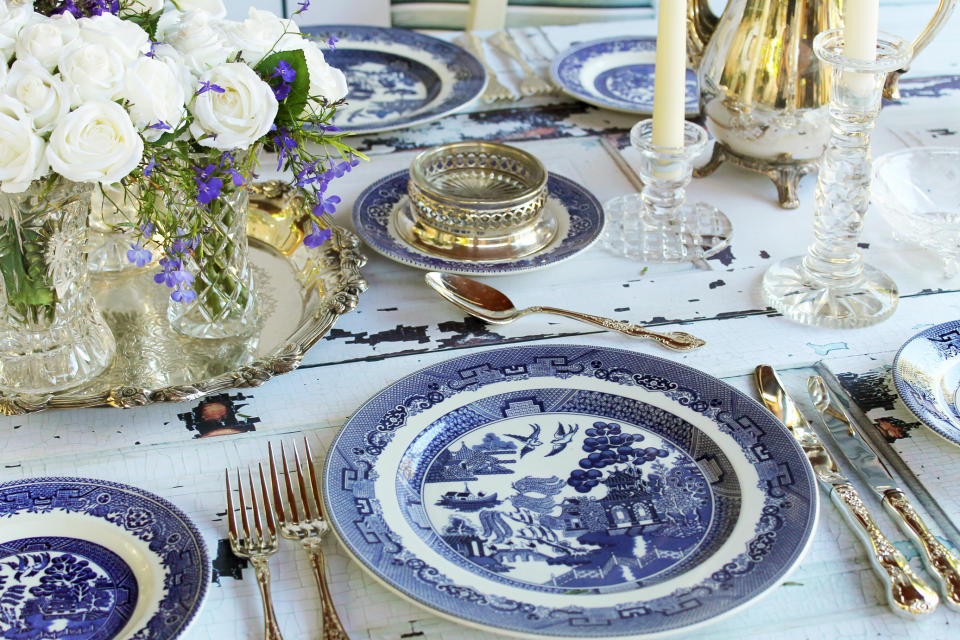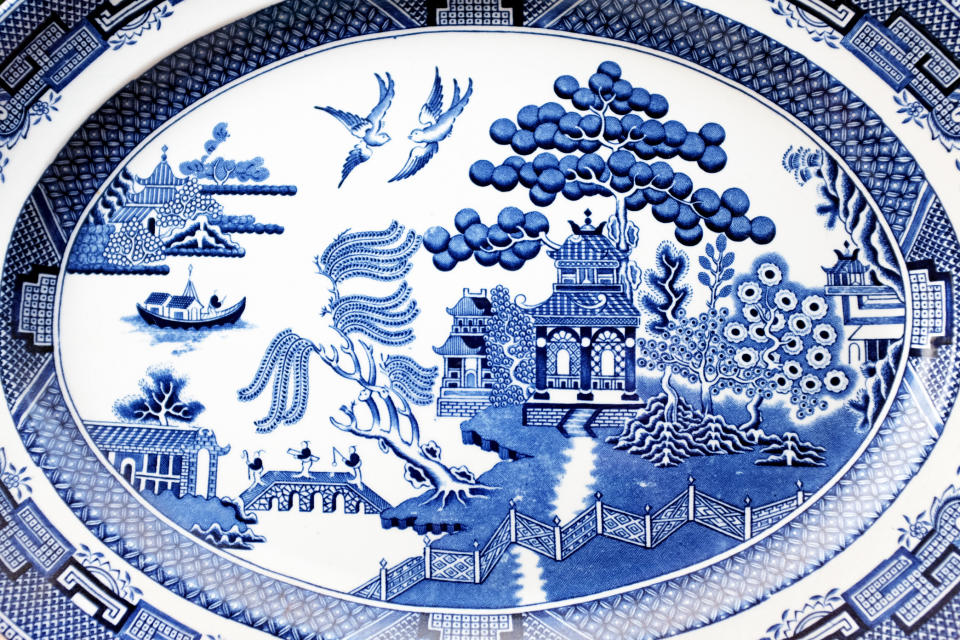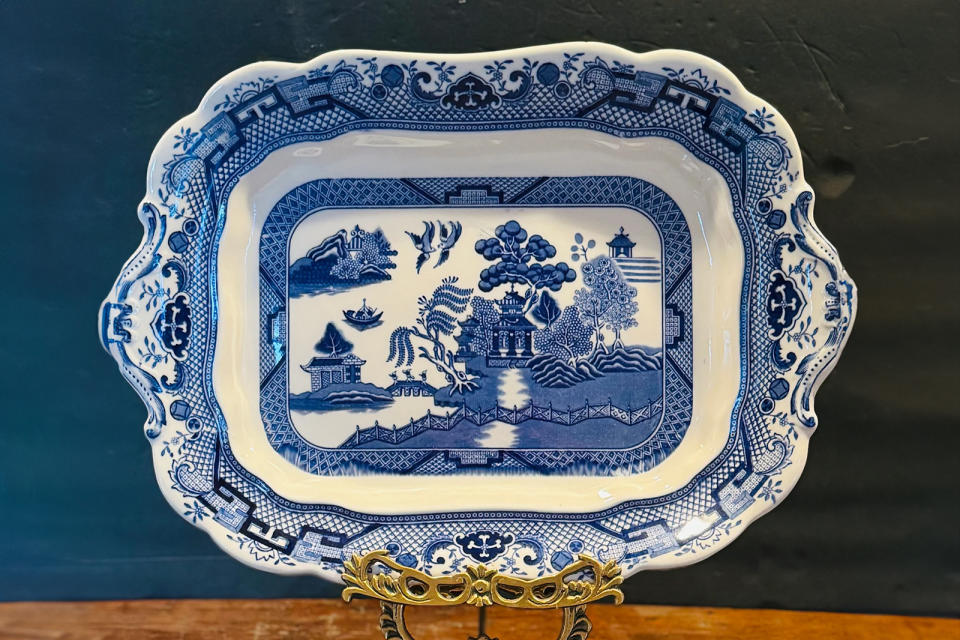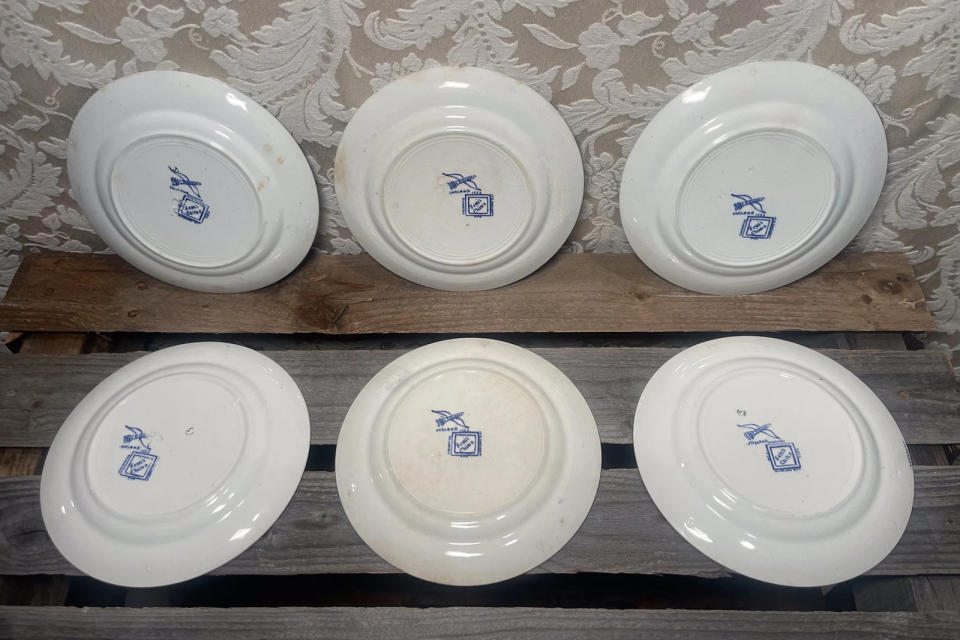
With an intricate design based on a Chinese legend, Blue Willow china is both beautiful and captivating. And here’s a bonus: it can also be valuable.
Whether you have some Blue Willow pieces inherited from your mother or grandmother or you’re planning to start your own collection, we promise learning more about this fascinating china pattern will make collecting it even more special.
Although there’s plenty of decorative and sentimental value to Blue Willow dinnerware (especially if the piece is a family heirloom), these dishes can also be worth a lot of money. If you know what’s worth the most, you’ll know what to watch for in antique stores (or your grandma’s china cabinet).
Blue Willow Dish | Approximate Value |
|---|---|
Tiffany & Co. Copeland Spode Blue Willow teapot | $700 |
Meissen Blue Willow gravy boat | $450 |
Large Blue Willow serving platter | $400 |
Tiffany & Co. Copeland Spode Blue Willow plate | $300 |
English Staffordshire Blue Willow cow-shaped creamer | $250 |
These are some of the most valuable Blue Willow pieces that have sold recently.
A Tiffany & Co. Copeland Spode Blue Willow teapot in pristine condition sold for almost $700. From the marks on the bottom, it dated to about 1880.
A 1940s Meissen Blue Willow gravy boat with an attached under-plate sold for about $450. It was in beautiful shape with no chips or damage.
A Blue Willow serving platter with the classic design sold for just under $400. It dated to the 19th century and measured 13.75 inches by 19 inches.
A Tiffany & Co. Copeland Spode Blue Willow plate with gilt accents sold for about $300. The plate measures 9.5 inches in diameter and has a subtle octagon shape.
An antique English Staffordshire Blue Willow cow-shaped creamer with a matching lid sold for about $250. It dated to 1840 and was in lovely condition.
If you grew up eating off Blue Willow dishes, you’re not alone. Developed by Thomas Turner in 1779, the Blue Willow pattern eventually became a classic fixture on many tables around the world. The pattern is actually English, although it is based on similar blue landscape designs in Chinese porcelain.

By the end of the 18th century, several English potteries were making Blue Willow patterns, which immediately captivated consumers’ imaginations. Potteries continued to make Blue Willow throughout the 19th and 20th centuries, and it is still made today. Part of what makes Blue Willow so popular is the story it tells in its design.
Blue Willow Legend
In the Blue Willow legend, the beautiful daughter of a powerful man fell in love with her father’s secretary. Discovering their love, the father banished the secretary and constructed a great fence to keep his daughter contained. She could only walk by the water and the willows. She despaired until she received a message from her lover. At a banquet, he rescued her, but her father noticed and chased them across a bridge. They got away, but years later, her father caught up with them. The secretary was killed, and the daughter died as well. In pity, the gods turned them both into doves so they could fly together forever.
Motifs on the China Pattern
If you’ve ever spent some time looking at it, you already know that Blue Willow china is highly symbolic with many motifs from this legend in the design. If you look closely, you’ll see the fence the father built to keep his daughter in, the bridge he chased the lovers across, the willow and stream by which the daughter walked, and many more elements of the legend. At the top, there are two doves to represent the couple.
This distinctive china pattern holds an important place in antique dinnerware history. Versions of it were made by dozens of different potteries. These have subtle variations, and some are more desirable than others. Additionally, companies have made this pattern for over 200 years; there may be as many as 500 different manufacturers spanning this long period of production.
Churchill Blue Willow and other modern versions of the classic pattern can make it tricky to tell whether you have an old piece or a new one. Identifying a piece of Blue Willow china can be a complex process because of all the versions out there.
Look for the Willow Pattern
There are many Chinese-inspired motifs that look similar to Blue Willow, but they may not have the characteristic pattern of the Blue Willow legend. Identifying this china pattern is easy. Look for the fence, the bridge, the two doves, the willow tree, and the stream. If it doesn’t have this pattern, it isn’t Blue Willow.

Learn to Recognize Transferware
Blue Willow is a transferware pattern. Transferware is made when an engraved plate is inked and pressed onto tissue. The tissue is then used to transfer the design onto the piece. This process creates a delicate, repeating pattern, usually all one color. There may be subtle lines where the tissue was crinkled or where motifs joined together. You’ll usually see willowware in the classic blue color, but you may also see it in colors like pink, black, brown, and green.
Related: Flow Blue Antique China: Prices & Patterns
Look for Marks
Many Blue Willow pieces feature a mark, but some do not. Turn the piece over and look on the back or bottom for any stamped designs. If there’s a stamp, you can look it up to find the company that made the piece. After 1891, English pieces will feature a country of origin mark as well (handy for identifying a Blue Willow dish from English companies).
It’s sometimes impossible to tell which pottery made a piece. The earliest pieces were often unmarked. Sometimes, pieces feature a small initial on the bottom that is a potter’s mark. The potters might move from one pottery to another, using the same mark at different companies. A mark can help you with identification, but unless it clearly states the name of the pottery, you may need to use other clues.
Don’t stress if your Blue Willow china isn’t marked at all. This is common, and it doesn’t mean your piece is less valuable. In fact, if it doesn’t have any mark, it could even mean it’s very old.
Look for Clues About the Date
There are some clues that can help you determine whether you have a piece of antique Blue Willow china or a modern reproduction:
Some new pieces are unmarked, although they will often say “Made in China” or have another modern backstamp.
Early Blue Willow pieces have a softer glaze and a lighter overall feel.
Older pieces may have some signs of crazing or light cracking on the surface of the glaze.
Some marked pieces offer clues because the mark was only used for a certain period at that pottery.
American potteries did not begin producing Blue Willow until after 1905 when the Buffalo Pottery Company issued the pattern.
Wondering if your Blue Willow china is real or fake? A modern reproduction is often heavier, and the design may be less delicate.
The value of antique Blue Willow china really depends on a variety of factors. Before assigning the value, take a look at the piece and see what you can find out about it.
Note Features and Marks
If the piece has a maker’s mark, note that. Also, try to identify the type of piece you have. If it’s a plate or bowl, it may be easy to find a value. Less common pieces, like soup tureens and specialty items, may be more challenging, but if you can identify them, the rarer pieces may be worth more.
Assess Condition
Like any antique item, condition will affect the value of a piece. Look for chips, cracks, repairs, staining, and crazing. In older pieces, these condition issues may have less impact on the value, but they still matter. Items in excellent condition are worth the most.
Look for Similar Pieces That Have Sold
Once you identify your Blue Willow piece, you can look up the sales prices of similar pieces online. Always check the price for sold items, not for items currently listed for sale. Make sure you’re comparing your piece to something that is the same in terms of manufacturer, size, type, and condition.
If you’re in doubt about the history or value of your Blue Willow china, it’s a good idea to have it appraised. As with all vintage items, antique dish values can vary widely. With its long and storied history, Blue Willow is a sought-after pattern that may be very valuable. Doing your research will help ensure you get a fair price for pieces you plan to sell or pay a reasonable price for those items you add to your collection.
EMEA Tribune is not involved in this news article, it is taken from our partners and or from the News Agencies. Copyright and Credit go to the News Agencies, email news@emeatribune.com Follow our WhatsApp verified Channel











